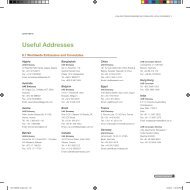Arab World Competitiveness Report 2011-2012 - World Economic ...
Arab World Competitiveness Report 2011-2012 - World Economic ...
Arab World Competitiveness Report 2011-2012 - World Economic ...
You also want an ePaper? Increase the reach of your titles
YUMPU automatically turns print PDFs into web optimized ePapers that Google loves.
Executive Summary<br />
<strong>Arab</strong> <strong>World</strong> <strong>Competitiveness</strong> <strong>Report</strong> <strong>2011</strong>-<strong>2012</strong><br />
6<br />
The <strong>Arab</strong> world has seen many important shifts over the<br />
past decade. Almost ten years of relatively high economic<br />
growth slowed significantly with the global economic<br />
and financial crisis of 2008-2009. More recently, a wave<br />
of protests driven by longstanding socio-political and<br />
economic issues spread across several countries, leading<br />
to instability and the fall of the regimes in Tunisia, Egypt,<br />
and (after months of a violent revolution) Libya. These<br />
events – commonly known as the “<strong>Arab</strong> Spring” – have<br />
spurred major political changes, notably in Tunisia and<br />
Egypt, where new constitutions are being drafted and<br />
entirely new governments elected. Yet, political changes<br />
will have to be accompanied by structural economic<br />
reform if the root causes of the current events in the<br />
region are to be addressed.<br />
The recent developments have heightened awareness<br />
of key socio-economic challenges, the most important<br />
of them being creating more and better employment<br />
opportunities for the 2.8 million young people entering the<br />
labor markets every year. Reducing unemployment will<br />
have to focus on three groups that are disproportionately<br />
affected – the young, the educated, and women.<br />
Enhancing overall competitiveness should be part of the<br />
reform agenda to address the challenges and exploit<br />
the opportunities present in the Middle East and North<br />
Africa (MENA) region. Particularly needed are measures<br />
to support a vibrant, competitive, and entrepreneurial<br />
private sector. The private sector currently remains<br />
stifled by a business environment that is not conducive<br />
to the development of enterprises. Corruption, lack of<br />
transparency in government decision making, market<br />
distortion, and weak global and regional integration hinder<br />
competition and reduce efficiency.<br />
The development of a dynamic private sector would not<br />
only involve the promotion of domestic enterprise but also<br />
the opening up of the economy to trade and investment.<br />
Although the region has made progress in these areas,<br />
the significant increase of foreign direct investment (FDI)<br />
registered during the last decade has not been sufficient<br />
to reduce the high levels of unemployment. The recent<br />
decrease in FDI flows due to the global economic<br />
crisis and the impact of the <strong>Arab</strong> Spring on investors’<br />
confidence brings additional challenges.<br />
Against this background, The <strong>Arab</strong> <strong>World</strong><br />
<strong>Competitiveness</strong> <strong>Report</strong> <strong>2011</strong>-<strong>2012</strong> analyzes the region’s<br />
competitive strengths and areas requiring improvement<br />
in chapter 1; examines the challenges and opportunities<br />
for reform in chapter 2; and provides an overview of the<br />
impact of FDI on employment and outlines some policy<br />
measures which could enhance that impact in chapter 3.<br />
Chapter 1, entitled “A Time of Opportunities: The<br />
<strong>Competitiveness</strong> Performance of the <strong>Arab</strong> <strong>World</strong>” by<br />
Margareta Drzeniek Hanouz and Miroslav Dusek (<strong>World</strong><br />
<strong>Economic</strong> Forum), analyzes the competitiveness of<br />
14 <strong>Arab</strong> countries using the framework of the Global<br />
<strong>Competitiveness</strong> Index (GCI). Competitive economies<br />
are those that are likely to grow over the medium to<br />
longer term and have in place the policies, factors, and<br />
institutions that support productivity. Productivity is a<br />
determining factor for economic growth, which in turn is<br />
needed to generate employment.<br />
The analysis shows that the countries are highly diverse<br />
in terms of national competitiveness, yet some common<br />
features can be identified among the three geographical<br />
sub-regions: the Gulf economies, North Africa, and<br />
the Levant. Most Gulf economies benefit from vast<br />
natural resources and rising energy prices, and have<br />
used the resulting revenues for improvements in their<br />
competitiveness in recent years. While North African and<br />
Levantine economies face numerous impediments, the<br />
current socio-political momentum does offer a unique<br />
opportunity for a robust response. These challenges<br />
include institutional concerns such as high levels of undue<br />
influence and corruption, weak domestic and foreign<br />
competition, underdeveloped financial markets, and rates<br />
of technological adoption that trail other economies at<br />
similar levels of development.<br />
Despite the considerable differences among nations, the<br />
common denominator across the region is the imperative<br />
to provide sustainable and gainful employment.<br />
<strong>Competitiveness</strong>-enhancing reforms can be instrumental<br />
in this context, as they contribute to employment creation<br />
in the long run. The two key reforms that would address<br />
obstacles to job creation in almost all countries in the<br />
region are overhauling education systems to better<br />
respond to the needs of the rapidly evolving economy;<br />
and raising the efficiency of markets by moving towards<br />
healthier competition, fostering entrepreneurship, and<br />
supporting a more dynamic environment for enterprises.<br />
The <strong>Arab</strong> Spring has led to significant turbulence in the<br />
region, which has had negative effects on the economic<br />
performance of countries in the short term. This is likely<br />
to persist in the medium term, as well, depending on<br />
the success and direction of political reform. However,<br />
while uncertainty about the future social, political, and<br />
economic environment and a heightened awareness<br />
of institutional weaknesses may have adverse effects<br />
in the near future, the political changes underway and<br />
the recognition of the key role of the private sector<br />
in generating jobs and growth may drive the needed<br />
political momentum to enhance competitiveness over the<br />
medium to long term.





